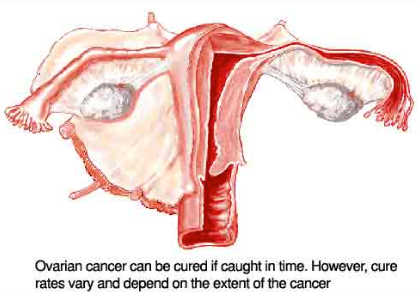Ovarian Tumor Removal in Estonia
Search and Compare the Best Clinics and Doctors at the Lowest Prices for Ovarian Tumor Removal in Estonia

Find the best clinics for Ovarian Tumor Removal in Estonia
No clinics available
Ukraine offers the best prices Worldwide
Price: $ 714

- Home
- Estonia
WHY US?
At Medijump, we're making medical easy. You can search, compare, discuss, and book your medical all in one place. We open the door to the best medical providers worldwide, saving you time and energy along the way, and it's all for FREE, no hidden fees, and no price markups guaranteed. So what are you waiting for?

Free

Best Price

Widest Selection

Risk-Free
What you need to know about Ovarian Tumor Removal in Estonia

Ovarian tumors are usually benign (non-cancerous), but if left untreated they may develop into Ovarian Cancer. If you have an ovarian tumor that grows and causes painful symptoms, you may need to undergo ovarian tumor removal, which is a surgical procedure to remove the tumor and sometimes the affected ovary or the surrounding tissue as well.
What does a Ovarian Tumor Removal Procedure Involve?
Ovarian tumor removal can be carried out with laparoscopy or laparotomy depending on the size of the tumor, both are done under general anesthetic. Your surgeon may only remove the tumor and leave the rest of the ovary intact or remove the entire ovary and fallopian tube. If the tumor is malignant (cancerous), your surgeon may remove part or all of the abnormal growth (ovarian tumor debulking).
How Long Should I Stay in Estonia for a Ovarian Tumor Removal Procedure?
You will need to stay in the hospital for 3 to 7 days after the surgery, but you should plan to stay in Estonia for 14 days. During your stay, you will attend follow-up hospital checkups where your surgeon monitors your condition and your surgeon will also remove the stitches.
What's the Recovery Time for Ovarian Tumor Removal Procedures in Estonia?
You may be able to go back to work within 4 weeks, but it is advisable to wait around 6 weeks to get back to your normal activities. During your recovery period, avoid intense exercises, heavy lifting, and sexual intercourse.
What sort of Aftercare is Required for Ovarian Tumor Removal Procedures in Estonia?
After the surgery, your surgeon will give you instructions regarding your diet, exercise, and wound care. You may need to meet your local doctor regularly so they can make sure your tumor and/or cancer has not come back. It is also advisable to see a therapist or counselor to talk to about emotional changes that ovarian tumor removal can cause.
What's the Success Rate of Ovarian Tumor Removal Procedures in Estonia?
Ovarian tumor removal has a high success rate of about 90%. However, just like any surgery, there are always side effects and risks that come with this type of surgery, including infection, bleeding and damage to nearby organs (such as the ureters and bladder). If both of your ovaries are removed, the side effect is menopause, infertility, dry vagina, hot flashes, night sweats, fatigue, and mood shifts.
Are there Alternatives to Ovarian Tumor Removal Procedures in Estonia?
In some cases, if your tumor is benign, you may need no treatment. Instead, your doctor may use “watchful waiting” to ensure the tumor does not cause any problems. If your tumor is malignant, your alternative is systemic therapies, such as hormone therapy, chemotherapy, and targeted therapy.
What Should You Expect Before and After the Procedure
Ovarian tumors can cause painful symptoms and cancerous. After ovarian tumor removal, you should not feel any of these symptoms anymore and you no longer will have a tumor in your ovary. Also, the chance of cancer spreading to other parts of your body is reduced and your fertility is usually preserved after treatment.
Whilst the information presented here has been accurately sourced and verified by a medical professional for its accuracy, it is still advised to consult with your doctor before pursuing a medical treatment at one of the listed medical providers
No Time?
Tell us what you're looking for and we'll reachout to the top clinics all at once
Enquire Now

Popular Procedures in Estonia
Prices Start From $260

Prices Start From $714

Prices Start From $714

Recommended Medical Centers in Estonia for procedures similar to Ovarian Tumor Removal

- Interpreter services
- Translation service
- Religious facilities
- Medical records transfer
- Medical travel insurance
- Health insurance coordination
- TV in the room
- Safe in the room
- Phone in the room
- Private rooms for patients available

- Interpreter services
- Translation service
- Religious facilities
- Medical records transfer
- Medical travel insurance
- Health insurance coordination
- TV in the room
- Safe in the room
- Phone in the room
- Private rooms for patients available

- Interpreter services
- Translation service
- Religious facilities
- Medical records transfer
- Medical travel insurance
- Health insurance coordination
- TV in the room
- Safe in the room
- Phone in the room
- Private rooms for patients available

- Interpreter services
- Translation service
- Religious facilities
- Medical records transfer
- Medical travel insurance
- Health insurance coordination
- TV in the room
- Safe in the room
- Phone in the room
- Private rooms for patients available

- Interpreter services
- Translation service
- Religious facilities
- Medical records transfer
- Medical travel insurance
- Health insurance coordination
- TV in the room
- Safe in the room
- Phone in the room
- Private rooms for patients available

- Interpreter services
- Translation service
- Religious facilities
- Medical records transfer
- Medical travel insurance
- Health insurance coordination
- TV in the room
- Safe in the room
- Phone in the room
- Private rooms for patients available

- Interpreter services
- Translation service
- Religious facilities
- Medical records transfer
- Medical travel insurance
- Health insurance coordination
- TV in the room
- Safe in the room
- Phone in the room
- Private rooms for patients available

- Interpreter services
- Translation service
- Religious facilities
- Medical records transfer
- Medical travel insurance
- Health insurance coordination
- TV in the room
- Safe in the room
- Phone in the room
- Private rooms for patients available

- Interpreter services
- Translation service
- Religious facilities
- Medical records transfer
- Medical travel insurance
- Health insurance coordination
- TV in the room
- Safe in the room
- Phone in the room
- Private rooms for patients available

- Interpreter services
- Translation service
- Religious facilities
- Medical records transfer
- Medical travel insurance
- Health insurance coordination
- TV in the room
- Safe in the room
- Phone in the room
- Private rooms for patients available
Ovarian Tumor Removal in and around Estonia
Introduction
Estonia is a country situated on the eastern coast of the Baltic Sea in Northern Europe. Tourism in this country is often overlooked, but those who have visited agree that the country is filled with historical wonders and hidden attractions. Today, Estonia has become a popular medical tourism destination, with a growing number of people coming from Sweden, Finland, Norway, and the UK. Foreign patients usually come for orthopedic, weight loss, or plastic surgery. What attracts medical tourists to have their treatment in Estonia is the country’s affordable and high-quality healthcare. With skilled surgeons, excellent medical centers, and incredible vacation opportunities, it is easy to see why Estonia is becoming more and more popular. Many of the board-certified surgeons in the country continue their training abroad and the private hospitals are armed with advanced technology.
Popular Cities and Regions in Estonia
The capital of Estonia is Tallinn and it charms visitors with its lively yet peaceful vibe, UNESCO-listed Old Town, photogenic sights, ancient churches, and medieval streetscapes. The city is perfect for those looking for some relaxation and pampering as it has a number of Day Spas. In addition, Tallinn is filled with delightful food and vibrant modern culture, making it the perfect place to visit. Besides Tallinn, another popular place to visit is Tartu, which is the second-largest city in the country. As a premier university town, this city is the place where Estonian doctors and surgeons study medicine. Tartu is a very historic city and also has a vibrant nightlife.
Transport in Estonia
Tallinn International Airport is the largest airport in Estonia that serves flights to and from major cities in Europe and the Middle East, such as London, Copenhagen, and Dubai. Getting around Estonia can be done by bus or train. While the rail network is limited and affordable, buses are fast and efficient. Big cities in the country have an efficient public transportation system and taxis are widely available. It is also worth pointing out that the whole country is bicycle-friendly.
Visas in Estonia
Since Estonia is a member state of the Schengen Area, holders of passports from 62 countries, including the US, the UAE, Japan, and Australia can enter without a visa for up to 90 days. Other countries not listed in the visa waiver agreement need to apply for a Schengen visa to enter.
Weather in Estonia
The summer months of June to August have the highest temperatures, with sunny and long daylight days. Spring (March to May) and autumn (September to October) is a great time to visit the country as the weather is very pleasant. Winter, from November to February, can be freezing as the temperatures plummet and the snow starts to fall. The weather in this country is very changeable.
Additional Info
- Local Currency: Estonia adopted the Euro (EUR) in 2011. 1 EUR is approx. 1.08 USD.
- Money & Payments: ATMs can be found in all cities and credit cards are widely accepted. Tipping is expected.
- Local Language: The official language is Estonian but Russian and English is widely spoken. Some people in the country also speak Finnish and German.
- Local Culture and Religion: More than half of Estonia’s population is non-religious. The religious population is mainly Christian.
- Public Holidays: Estonia celebrates various public holidays, including Independence Day, Good Friday, Easter Sunday, Spring Day, Pentecost Sunday, Victory Day, Independence Restoration Day, and Christmas Day.
Popular Searches
- Plastic Surgery in Thailand
- Dental Implants in Thailand
- Hair Transplant in Thailand
- Breast Augmentation Thailand
- Gastric Sleeve in Thailand
- Gender Reassignment Surgery in Thailand
- Laser Hair Removal in Bangkok
- Botox in Bangkok
- Dermatology in Bangkok
- Breast Augmentation in Bangkok
- Coolsculpting in Bangkok
- Veneers in Turkey
- Hair Transplant in Turkey
- Rhinoplasty in Turkey
- Stem Cell Therapy in Mexico
- Rhinoplasty in Mexico
- Liposuction in Mexico
- Coolsculpting in Tijuana
- Rhinoplasty in Korea
- Scar Removal in Korea
- Gastric Sleeve in Turkey
- Bone Marrow Transplant in India
- Invisalign in Malaysia
- Plastic Surgery in the Dominican Republic
- Tummy Tuck in the Dominican Republic
- Plastic and Cosmetic Surgery in Poland
- Rhinoplasty in Poland
- Hair Implant in Poland
- Dental Implants in Poland
- IVF in Turkey